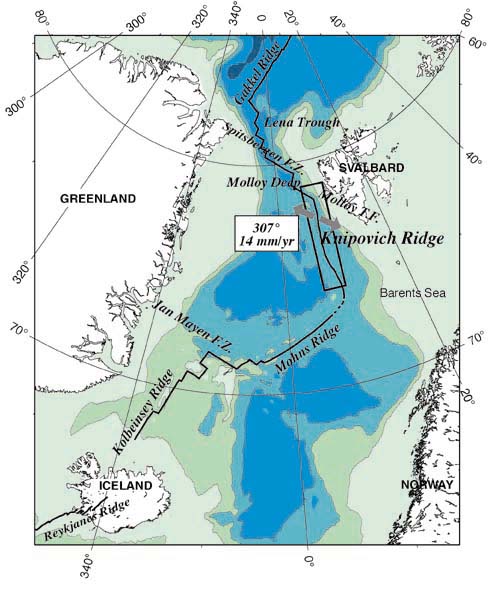Knipovich Ridge segmentation
|
 |
Bathymetry, gravity and deep-tow sonar image data are used to define the segmentation of a 400 km long portion of the ultraslow-spreading Knipovich Ridge in the Norwegian-Greenland Sea, Northeast Atlantic Ocean. Discrete volcanic centers marked by large volcanic constructions and accompanying short wavelength mantle Bouguer anomaly (MBA) lows generally resemble those of the Gakkel Ridge and the easternmost Southwest Indian Ridge (SWIR). These magmatically robust segment centers are regularly spaced about 85-100 km apart along the ridge, and are characterized by accumulated hummocky terrain, high relief, off-axis seamount chains and significant MBA lows. We suggest that these eruptive centers correspond to areas of enhanced magma flux, and that their spacing reflects the geometry of underlying mantle upwelling cells. |
 |
The large-scale thermal structure of the mantle primarily controls discrete and focused magmatism, and the relatively wide spacing of these segments may reflect cool mantle beneath the ridge. Segment centers along the southern Knipovich Ridge are characterized by lower relief and smaller MBA anomalies than along the northern section of the ridge. This suggests that ridge obliquity is a secondary control on ridge construction on the Knipovich Ridge, as the obliquity changes from 35deg. to 49deg. from north to south, respectively, while spreading rate and axial depth remain approximately constant. |
| The increased obliquity may contribute to decreased effective spreading rates, lower upwelling magma velocity and melt formation, and limited horizontal dike propagation near the surface. We also identify small, magmatically weaker segments with low relief, little or no MBA anomaly, and no off axis expression. We suggest that these segments are either fed by lateral melt migration from adjacent magmatically stronger segments or represent smaller, discrete mantle upwelling centers with short-lived melt supply. |
 |